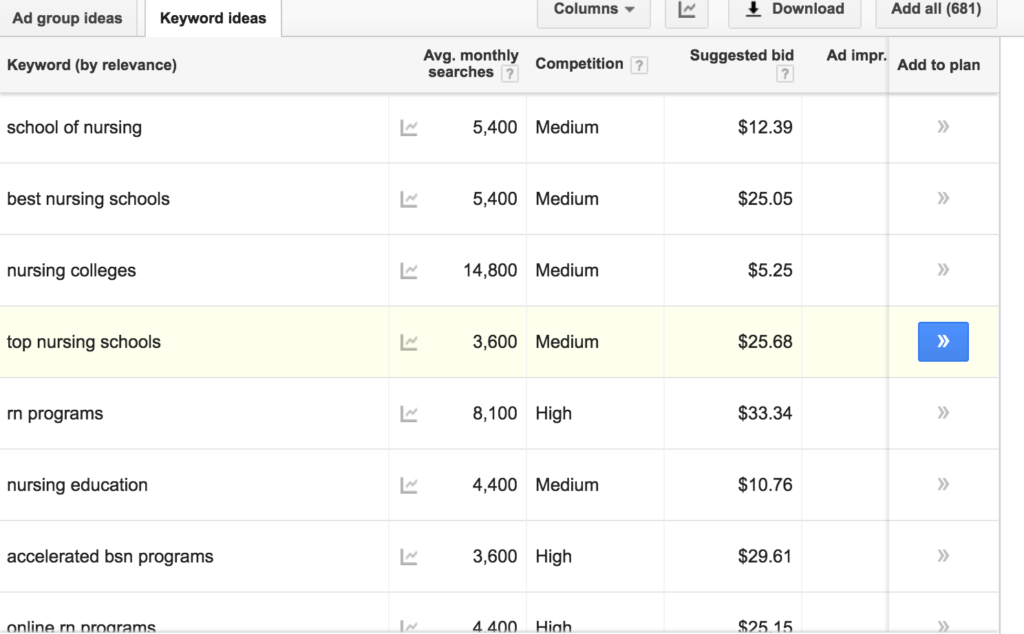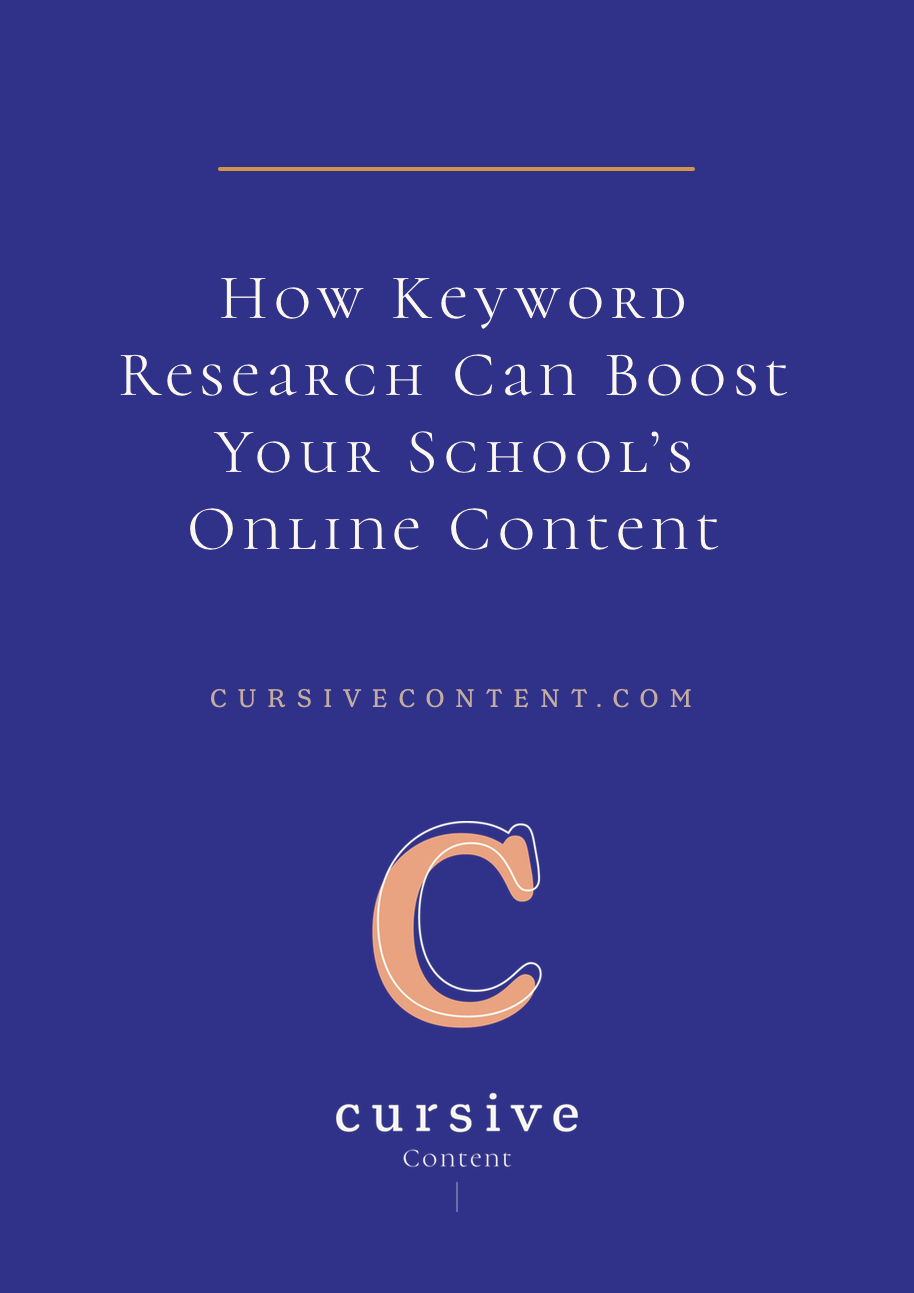How Keyword Research Can Boost Your School’s Online Content

Did you know that the first result in a Google search gets around 33% of traffic? And it’s all downhill from there. By the time you get to the tenth result, only around 2.4% of people are clicking.1
In other words, ranking well in search is really big deal for your online content— and therefore, for your school.
There is a lot that goes into those rankings. There many things that even the most well-respected SEO pro doesn’t know, because Google doesn’t announce algorithm updates and doesn’t fully explain how results are ranked.
Despite the complications and uncertainties, there are some things that even the least SEO-savvy marketers can do to improve their search rankings. One of those things is keyword research.
Keyword research helps you write using terms that people are actually using in search.
When you use those exact terms, you increase your chances of ranking high in search, which increases the traffic to your page.
The more prospective students and families visit your website, the more inquiries you’ll receive and the more applicants you’ll have. And it all starts with understanding keywords, how to do keyword research, and how to apply what you find to your school’s online content.
What are keywords?
A keyword is a word or phrase used in an internet search; it’s the word or words people type in to Google.
“Keyword” doesn’t necessarily mean just one word, it can also refer to a phrase of any length. When a keyword is comprised of multiple words it is called a “long-tail keyword”—these are ideal because they are the most specific and you are more likely to rank highly for them.
For example: “Independent school” is a keyword. “All girls independent school in New England” is a long-tail keyword.
When writing for the web, you want to use the best possible keywords in your writing to improve your chances of landing on the first page of Google. Google has a number of algorithms they use to determine how pages rank, and keywords are just one piece of that puzzle—but an important piece.
If thinking about algorithms starts to feel too technical, think of it like this: you want the words you use to match the words your ideal audience is searching for.
Note: Don’t confuse on-page keywords with meta keywords, which are an outdated practice related to the back end of your website. If you’re a little confused on the difference, we talk about meta keywords in this post.
How to use keywords in your writing
The most important part about writing for the web is writing great content that connects with your audience. Keywords should help shape your writing, but not define it.
When writing, you will naturally use a variety of words to describe your school, its programs and services. When you’ve done keyword research, you are aware of the best words to use and can weave them into your writing.
You cannot trick Google with techniques like keyword stuffing (the practice of overloading a page with keywords), since Google’s algorithms are way too smart for that now. Besides, content that is stuffed with keywords doesn’t sound good, so no one will want to read it—and that is the opposite of the reason why you want to use keywords in the first place.
To make the best use of keywords, choose a target keyword for each piece of content you create on the web (such as website pages and blog posts) that is a perfect match for what your page content is actually about. Then use that exact phrasing whenever it fits with the flow of your writing.
Find keywords with Google Keyword Planner
Google has a free Keyword Planner you can use to discover the terms that people are using in search. This tool was created to help with Google ad campaigns, but you don’t need to be an advertiser in order to use it.
You can enter any keyword and see data related to that keyword—for our purposes, we’ll focus on the average monthly searches and competition for that keyword, along with the related keywords and ad groups Google shows in the results.
How to find keywords: Monthly searches and competition data
When you are deciding on the primary keyword for a page, look at what Google shows for average monthly searches and competition: ideally, you want a keyword that has a high number of monthly searches and low competition, because this improves your chances for ranking high.
That is not always an easy combination to find, though, so use your best judgment by weighing searches, competition and the clout your school has in that area. For instance, if you’re launching a new program, your school and website won’t have any existing authority on the topic, and you’re better off choosing a keyword that has a lower amount of competition.
In contrast, if you have one of the top programs in the country, you can confidently chose a keyword with higher competition.
Before you change your primary keyword, take a look at where you rank in a Google search. If a keyword has a high number of searches and high competition, but you’re already ranking highly for that word, leave it!
How to find keywords: Keyword ideas & ad groups
After you enter a keyword, Keyword Planner will show you other keywords related to the one you searched—oftentimes you will be able to find an even better keyword to use, or the suggestions will spark ideas for different or long-tail keywords. You can also browse Ad Group Ideas, which collects groups of related keywords together.
We’ll explore a few different scenarios so you can see how this tool is helpful in informing your writing.
First, let’s imagine you are going to write a web page about your school’s nursing program. Your internal lingo might be to call it a “program”, so that’s what you default to in your writing. But if you look at Keyword Planner, you’ll find that “nursing program” has a high level of competition and just 12,100 searches. The keyword “nursing school”, while it still has a high level of competition, has 27,100 monthly searches. If applicable, “nursing school” would be the better of the two phrases based on search volume.

Both still have high levels of competition, though, so you might want to find a different keyword. If you continue to scroll down the list of suggested keywords Google gives you, you’ll find some keywords with lower monthly searches, but also lower competition. You might be able to use “school of nursing” as your focus keyword instead. While it doesn’t have as many searches, the lessened competition might make it possible for you to rank well for that keyword.

Now let’s take the search deeper to see if we can find a long-tail keyword.
To find a long-tail keyword, brainstorm some ways you can be more specific about your offering, the content that will appear on that specific page, and how people might search for it—then explore those ideas using a variety of different phrases and spellings.
Some ways you can expand on a short keyword are:
- Add location, i.e.
- “school of nursing” becomes “school of nursing in CT” (note that spelling matters: “school of nursing in Connecticut” is an entirely different search term that returns different results)
- “nursing schools” becomes “nursing schools in New York City”
- Add description, i.e.
- “nursing schools” becomes “nursing schools online”
- “nursing school” becomes “nursing school requirements”
- Rethink your base keyword and expand from there
- “RN programs” becomes “accelerated RN programs”
- “nursing programs” becomes “online nursing programs”
- “lpn to rn” becomes “lpn to rn bridge programs”
How to find keywords: Google’s related searches
Sometimes it’s not easy to think of ways to make a simple search term into a long-tail keyword. If you’re stumped, you can turn to Google search. Type in your search term, then head down to the bottom of the page where you’ll see the “Searches related to…” section.
Here is what Google shows when I search for “nursing schools”

And “nursing schools in new England”

These are popular searches related to the term you typed in, and might make good long-term keywords or provide a jumping off point for alternate keywords. Bring these new ideas back into the Keyword Planner tool to see how they measure up against other keywords.
Keyword research can be a time-consuming process, so keep track of the keywords you find in a simple spreadsheet. Then, the next time you write or edit a website page or blog post, you’ll have a list to refer to. Continue to grow that list over time and before you know it, keyword research will be a seamless part of your writing process.
Want more practical content tips? Get them for FREE in our Resource Library.
MORE ARTICLES
-
 Clarity in 50 Words or Less: How to Write Your School’s One-Sentence Story
Clarity in 50 Words or Less: How to Write Your School’s One-Sentence Story -
 The 4 Building Blocks of a Strong School Story (and Why AI Needs Them)
The 4 Building Blocks of a Strong School Story (and Why AI Needs Them) -
 How to Stop ChatGPT from Making Your School Sound Generic
How to Stop ChatGPT from Making Your School Sound Generic -
 What Should Your School Do with Its Blog Now That AI Is Changing Search?
What Should Your School Do with Its Blog Now That AI Is Changing Search? -
 What Is Your Private School’s Bold & Unifying Big Promise?
What Is Your Private School’s Bold & Unifying Big Promise? -
 Viewbook Best Practices for Private Schools
Viewbook Best Practices for Private Schools -
 AI Writing Prompts to Power Private School Storytelling
AI Writing Prompts to Power Private School Storytelling -
 How to Write a Magnetic Private School “About” Page
How to Write a Magnetic Private School “About” Page

